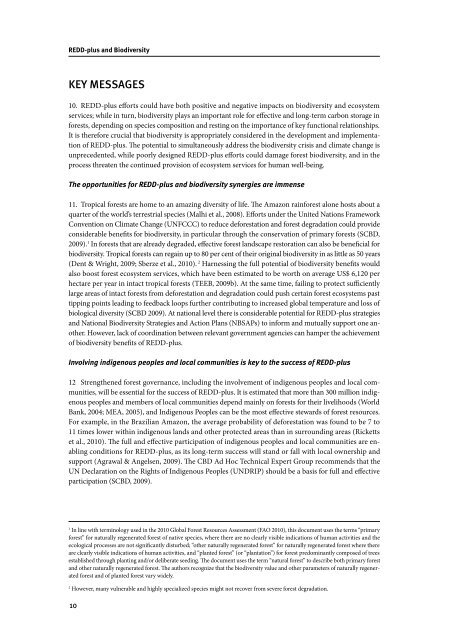REDD-plus and Biodiversity - Convention on Biological Diversity
REDD-plus and Biodiversity - Convention on Biological Diversity
REDD-plus and Biodiversity - Convention on Biological Diversity
You also want an ePaper? Increase the reach of your titles
YUMPU automatically turns print PDFs into web optimized ePapers that Google loves.
<str<strong>on</strong>g>REDD</str<strong>on</strong>g>-<str<strong>on</strong>g>plus</str<strong>on</strong>g> <str<strong>on</strong>g>and</str<strong>on</strong>g> <str<strong>on</strong>g>Biodiversity</str<strong>on</strong>g><br />
Key Messages<br />
10. <str<strong>on</strong>g>REDD</str<strong>on</strong>g>-<str<strong>on</strong>g>plus</str<strong>on</strong>g> efforts could have both positive <str<strong>on</strong>g>and</str<strong>on</strong>g> negative impacts <strong>on</strong> biodiversity <str<strong>on</strong>g>and</str<strong>on</strong>g> ecosystem<br />
services; while in turn, biodiversity plays an important role for effective <str<strong>on</strong>g>and</str<strong>on</strong>g> l<strong>on</strong>g-term carb<strong>on</strong> storage in<br />
forests, depending <strong>on</strong> species compositi<strong>on</strong> <str<strong>on</strong>g>and</str<strong>on</strong>g> resting <strong>on</strong> the importance of key functi<strong>on</strong>al relati<strong>on</strong>ships.<br />
It is therefore crucial that biodiversity is appropriately c<strong>on</strong>sidered in the development <str<strong>on</strong>g>and</str<strong>on</strong>g> implementati<strong>on</strong><br />
of <str<strong>on</strong>g>REDD</str<strong>on</strong>g>-<str<strong>on</strong>g>plus</str<strong>on</strong>g>. The potential to simultaneously address the biodiversity crisis <str<strong>on</strong>g>and</str<strong>on</strong>g> climate change is<br />
unprecedented, while poorly designed <str<strong>on</strong>g>REDD</str<strong>on</strong>g>-<str<strong>on</strong>g>plus</str<strong>on</strong>g> efforts could damage forest biodiversity, <str<strong>on</strong>g>and</str<strong>on</strong>g> in the<br />
process threaten the c<strong>on</strong>tinued provisi<strong>on</strong> of ecosystem services for human well-being.<br />
The opportunities for <str<strong>on</strong>g>REDD</str<strong>on</strong>g>-<str<strong>on</strong>g>plus</str<strong>on</strong>g> <str<strong>on</strong>g>and</str<strong>on</strong>g> biodiversity synergies are immense<br />
11. Tropical forests are home to an amazing diversity of life. The Amaz<strong>on</strong> rainforest al<strong>on</strong>e hosts about a<br />
quarter of the world’s terrestrial species (Malhi et al., 2008). Efforts under the United Nati<strong>on</strong>s Framework<br />
<str<strong>on</strong>g>C<strong>on</strong>venti<strong>on</strong></str<strong>on</strong>g> <strong>on</strong> Climate Change (UNFCCC) to reduce deforestati<strong>on</strong> <str<strong>on</strong>g>and</str<strong>on</strong>g> forest degradati<strong>on</strong> could provide<br />
c<strong>on</strong>siderable benefits for biodiversity, in particular through the c<strong>on</strong>servati<strong>on</strong> of primary forests (SCBD,<br />
2009). 1 In forests that are already degraded, effective forest l<str<strong>on</strong>g>and</str<strong>on</strong>g>scape restorati<strong>on</strong> can also be beneficial for<br />
biodiversity. Tropical forests can regain up to 80 per cent of their original biodiversity in as little as 50 years<br />
(Dent & Wright, 2009; Sberze et al., 2010). 2 Harnessing the full potential of biodiversity benefits would<br />
also boost forest ecosystem services, which have been estimated to be worth <strong>on</strong> average US$ 6,120 per<br />
hectare per year in intact tropical forests (TEEB, 2009b). At the same time, failing to protect sufficiently<br />
large areas of intact forests from deforestati<strong>on</strong> <str<strong>on</strong>g>and</str<strong>on</strong>g> degradati<strong>on</strong> could push certain forest ecosystems past<br />
tipping points leading to feedback loops further c<strong>on</strong>tributing to increased global temperature <str<strong>on</strong>g>and</str<strong>on</strong>g> loss of<br />
biological diversity (SCBD 2009). At nati<strong>on</strong>al level there is c<strong>on</strong>siderable potential for <str<strong>on</strong>g>REDD</str<strong>on</strong>g>-<str<strong>on</strong>g>plus</str<strong>on</strong>g> strategies<br />
<str<strong>on</strong>g>and</str<strong>on</strong>g> Nati<strong>on</strong>al <str<strong>on</strong>g>Biodiversity</str<strong>on</strong>g> Strategies <str<strong>on</strong>g>and</str<strong>on</strong>g> Acti<strong>on</strong> Plans (NBSAPs) to inform <str<strong>on</strong>g>and</str<strong>on</strong>g> mutually support <strong>on</strong>e another.<br />
However, lack of coordinati<strong>on</strong> between relevant government agencies can hamper the achievement<br />
of biodiversity benefits of <str<strong>on</strong>g>REDD</str<strong>on</strong>g>-<str<strong>on</strong>g>plus</str<strong>on</strong>g>.<br />
Involving indigenous peoples <str<strong>on</strong>g>and</str<strong>on</strong>g> local communities is key to the success of <str<strong>on</strong>g>REDD</str<strong>on</strong>g>-<str<strong>on</strong>g>plus</str<strong>on</strong>g><br />
12 Strengthened forest governance, including the involvement of indigenous peoples <str<strong>on</strong>g>and</str<strong>on</strong>g> local communities,<br />
will be essential for the success of <str<strong>on</strong>g>REDD</str<strong>on</strong>g>-<str<strong>on</strong>g>plus</str<strong>on</strong>g>. It is estimated that more than 300 milli<strong>on</strong> indigenous<br />
peoples <str<strong>on</strong>g>and</str<strong>on</strong>g> members of local communities depend mainly <strong>on</strong> forests for their livelihoods (World<br />
Bank, 2004; MEA, 2005), <str<strong>on</strong>g>and</str<strong>on</strong>g> Indigenous Peoples can be the most effective stewards of forest resources.<br />
For example, in the Brazilian Amaz<strong>on</strong>, the average probability of deforestati<strong>on</strong> was found to be 7 to<br />
11 times lower within indigenous l<str<strong>on</strong>g>and</str<strong>on</strong>g>s <str<strong>on</strong>g>and</str<strong>on</strong>g> other protected areas than in surrounding areas (Ricketts<br />
et al., 2010). The full <str<strong>on</strong>g>and</str<strong>on</strong>g> effective participati<strong>on</strong> of indigenous peoples <str<strong>on</strong>g>and</str<strong>on</strong>g> local communities are enabling<br />
c<strong>on</strong>diti<strong>on</strong>s for <str<strong>on</strong>g>REDD</str<strong>on</strong>g>-<str<strong>on</strong>g>plus</str<strong>on</strong>g>, as its l<strong>on</strong>g-term success will st<str<strong>on</strong>g>and</str<strong>on</strong>g> or fall with local ownership <str<strong>on</strong>g>and</str<strong>on</strong>g><br />
support (Agrawal & Angelsen, 2009). The CBD Ad Hoc Technical Expert Group recommends that the<br />
UN Declarati<strong>on</strong> <strong>on</strong> the Rights of Indigenous Peoples (UNDRIP) should be a basis for full <str<strong>on</strong>g>and</str<strong>on</strong>g> effective<br />
participati<strong>on</strong> (SCBD, 2009).<br />
1<br />
In line with terminology used in the 2010 Global Forest Resources Assessment (FAO 2010), this document uses the terms “primary<br />
forest” for naturally regenerated forest of native species, where there are no clearly visible indicati<strong>on</strong>s of human activities <str<strong>on</strong>g>and</str<strong>on</strong>g> the<br />
ecological processes are not significantly disturbed; “other naturally regenerated forest” for naturally regenerated forest where there<br />
are clearly visible indicati<strong>on</strong>s of human activities, <str<strong>on</strong>g>and</str<strong>on</strong>g> “planted forest” (or “plantati<strong>on</strong>”) for forest predominantly composed of trees<br />
established through planting <str<strong>on</strong>g>and</str<strong>on</strong>g>/or deliberate seeding. The document uses the term “natural forest” to describe both primary forest<br />
<str<strong>on</strong>g>and</str<strong>on</strong>g> other naturally regenerated forest. The authors recognize that the biodiversity value <str<strong>on</strong>g>and</str<strong>on</strong>g> other parameters of naturally regenerated<br />
forest <str<strong>on</strong>g>and</str<strong>on</strong>g> of planted forest vary widely.<br />
2<br />
However, many vulnerable <str<strong>on</strong>g>and</str<strong>on</strong>g> highly specialized species might not recover from severe forest degradati<strong>on</strong>.<br />
10

















